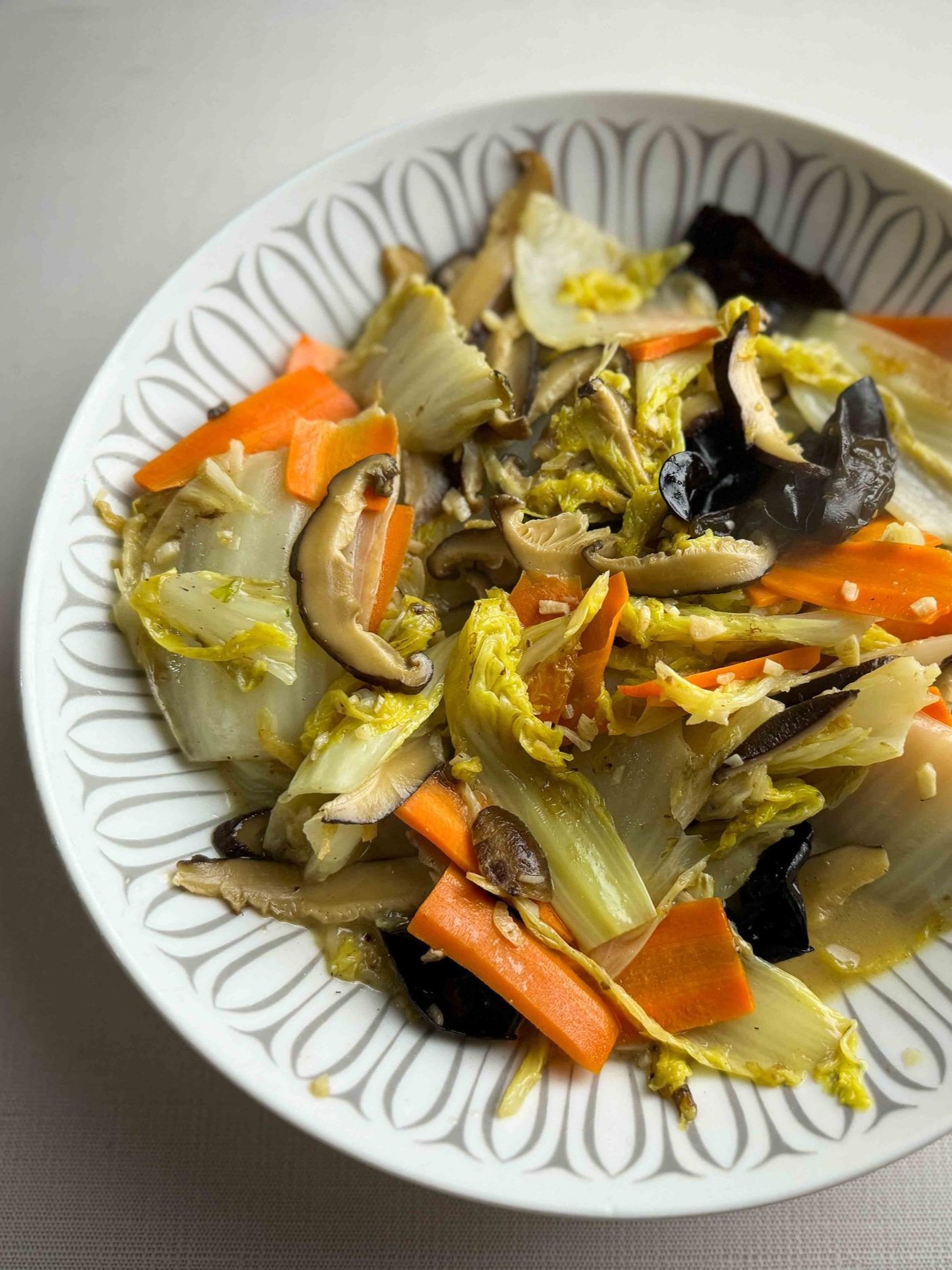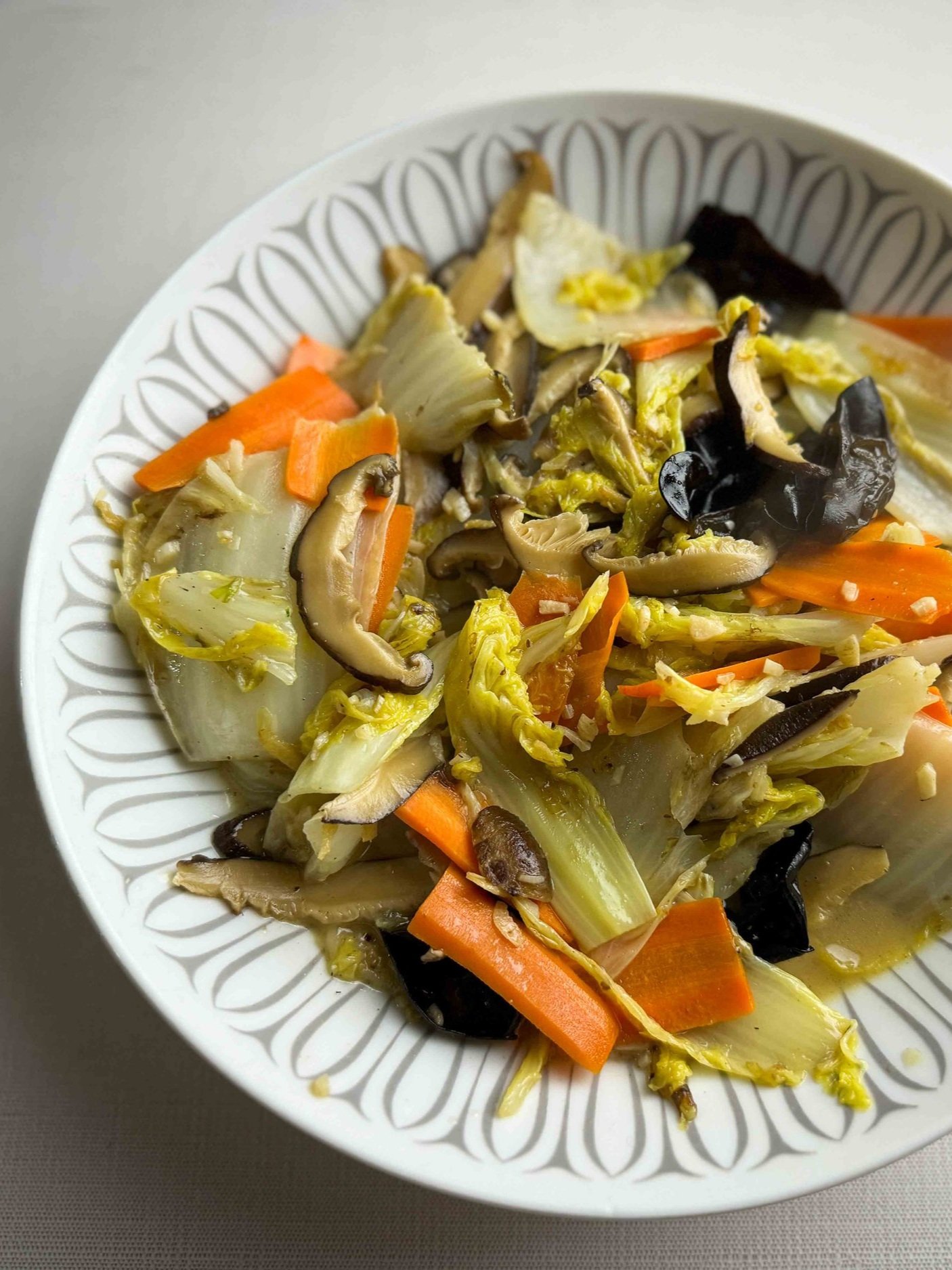Braised Napa Cabbage
This delightful Taiwanese dish answers the question of how to feature that beautiful napa cabbage that’s always beckoning in the supermarket: Pairing it with shiitake and wood ear mushrooms results in a plant-forward treat underlined with umami depth. The recipe is adapted from Made in Taiwan: Recipes and Stories from the Island Nation by Clarissa Wei with Ivy Chen.
READ: “Taiwanese and Taiwanese American culinary traditions shine in three exciting cookbooks”
Wei’s original recipe includes dried flounder in the ingredients, and notes that it can be found in “most Asian supermarkets in the States.” We were unable to find it, even in our local well stocked 99 Ranch Market — part of a chain founded, owned and run by a Taiwanese immigrant and his family. We used Wei’s suggested substitution, a couple of dashes of dashi powder. The recipe calls for either pork bone broth or low-sodium chicken broth. We used pork bone broth (see the second part of the recipe for Pickled Mustard and Pork Noodle Soup for the recipe). However, the broth isn’t a terribly important part of the recipe, and we expect it would be nearly as nice with purchased chicken broth.
Serves 2 to 4.
Ingredients
5 medium dried shiitake mushrooms
8 small dried wood ear mushrooms
1 tablespoon small dried shrimp
3 tablespoons canola or other neutral oil
4 garlic cloves, minced
1 pound / 450 grams Napa cabbage, ripped into 2-inch / 5-cm chunks
1 cup / 240 ml Pork Bone Broth or low-sodium chicken broth
1/2 teaspoon dashi powder (such as Hondashi)
1/2 large carrot (50 g), peeled and cut into thin 1 x 2-inch / 2.5 x 5-cm pieces
1/2 teaspoon sea salt, plus more to taste
1/8 teaspoon ground white pepper, plus more to taste
Instructions
1. In a medium bowl, cover the dried shiitake mushrooms with water, and soak until they’re soft, about 1 hour. (If you’re short of time, soak them in boiling water for 30 minutes, though they won’t be as flavorful.) In a medium heatproof bowl, cover the woodear mushrooms with boiling water, and soak for 30 minutes. In a small bowl, cover the dried shrimp with water and soak for 10 minutes.
2. Drain the dried shrimp through a fine-mesh sieve. Drain the wood ear mushrooms, and with a knife or scissors, trim off any craggy bits. If they’re larger than a half-dollar, cut them in half. Remove the shiitakes from the bowl and squeeze out excess water. Trim the stems off and discard. Thinly slice the caps and set aside.
3. In a wok set over medium-high heat the oil. Add the dried shrimp, sliced shiitakes and garlic, stirring until fragrant, about 20 seconds. Toss in the napa cabbage, and stir-fry to combine, about 2 minutes. Pour in the bone broth or chicken broth, the dashi powder and the wood ear mushrooms. Bring the liquid to a rolling boil. Stir again, cover and reduce the heat to low. Simmer, stirring occasionally, until the cabbage is soft and wilted, 10 to 12 minutes. Add the carrots and cook, covered, for another 3 minutes. Turn off the heat and season with salt and white pepper, adding more if you’d like. Enjoy while hot.

Braised Napa Cabbage
Ingredients
- 5 medium dried shiitake mushrooms
- 8 small dried wood ear mushrooms
- 1 tablespoon small dried shrimp
- 3 tablespoons canola or other neutral oil
- 4 garlic cloves, minced
- 1 pound / 450 grams Napa cabbage, ripped into 2-inch / 5-cm chunks
- 1 cup / 240 ml Pork Bone Broth or low-sodium chicken broth
- 1/2 teaspoon dashi powder (such as Hondashi)
- 1/2 large carrot (50 g), peeled and cut into thin 1 x 2-inch / 2.5 x 5-cm pieces
- 1/2 teaspoon sea salt, plus more to taste
- 1/8 teaspoon ground white pepper, plus more to taste
Instructions
- In a medium bowl, cover the dried shiitake mushrooms with water, and soak until they’re soft, about 1 hour. (If you’re short of time, soak them in boiling water for 30 minutes, though they won’t be as flavorful.) In a medium heatproof bowl, cover the woodear mushrooms with boiling water, and soak for 30 minutes. In a small bowl, cover the dried shrimp with water and soak for 10 minutes.
- Drain the dried shrimp through a fine-mesh sieve. Drain the wood ear mushrooms, and with a knife or scissors, trim off any craggy bits. If they’re larger than a half-dollar, cut them in half. Remove the shiitakes from the bowl and squeeze out excess water. Trim the stems off and discard. Thinly slice the caps and set aside.
- In a wok set over medium-high heat the oil. Add the dried shrimp, sliced shiitakes and garlic, stirring until fragrant, about 20 seconds. Toss in the napa cabbage, and stir-fry to combine, about 2 minutes. Pour in the bone broth or chicken broth, the dashi powder and the wood ear mushrooms. Bring the liquid to a rolling boil. Stir again, cover and reduce the heat to low. Simmer, stirring occasionally, until the cabbage is soft and wilted, 10 to 12 minutes. Add the carrots and cook, covered, for another 3 minutes. Turn off the heat and season with salt and white pepper, adding more if you’d like. Enjoy while hot.




